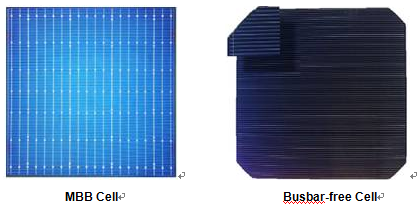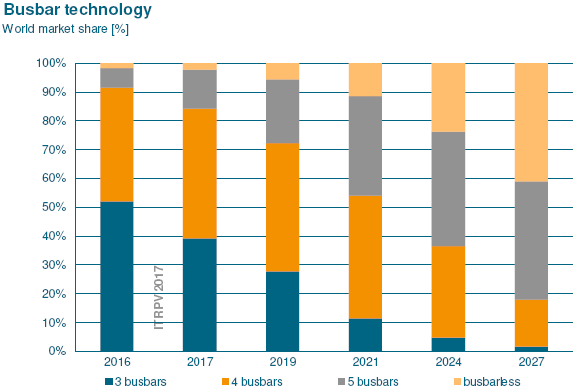Feb 28, Longi Solar held news release conference on Japan PV EXPO, official declared that after test and authentication of CPVT, its mono-Si PERC cell highest efficiency has reached 23.6%, and becomes new world record holder.
Continuous refreshed PERC cell efficiency record
PERC (Passivated Emitter and Rear Cell) uses rear side passivation technology, reduces back surface recombination, and strengthens internal reflection of light on silicon base, and it is a kind of high efficiency cell structure which can effectively increase cell efficiency. PV industry actively invests to PERC technology makes PERC cell efficiency continue increasing.
In recent half year, world record of PERC cell transfer efficiency continuous refreshed, shows strong vitality of PERC.
●Oct 2, 2017, JinkoSolar announced that its R&D effective area (245.83cm2) P type multi-Si PERC cell transfer efficiency reached 22.04%, broke new world record;
●Oct 17, 2017, Longi Solar announced that, after test and authentication of Fraunhofer Institute of Solar Energy Systems, its mono-Si PERC cell photoelectric transfer efficiency reached 22.71%, broke new PERC world record;
●Oct 26, 2017, JinkoSolar announced that, after authentication of CAS, its R&D P type mono-Si PERC cell transfer efficiency reached 22.78%, broke new world record;
●Oct 27, 2017, Longi Solar announced that, it received test report of CPVT. The report shows that its mono-Si PERC cell transfer efficiency highest level reached 23.26, broke new world record;
●Nov 8, 2017, JinkoSolar announced that, after authentication of Solar PV Power Generation System and Wind Power Generation System Quality Test Center, its P type mono-Si PERC multi bus bar cell efficiency reached 23.45%, broke P type mono-Si cell efficiency world record again;
●Feb 28, 2018, Longi Solar announced that after test and authentication of CPVT, its mono-Si PERC cell highest transfer efficiency has reached 23.6%, becomes new world record holder again.
Metalized paste assists PERC cell efficiency increase
Professional insiders state that, mass production type PERC cell efficiency is expected to break 24%, and it can be seen that PERC cell transfer efficiency still has space for further breakthroughs. Conductive paste is key material to increase cell efficiency, as rear side structure of PERC cell is different from conventional c-Si cell, it comes up with new challenges to metalized paste rear side Al paste, rear side Ag paste and front side Ag paste.
Front electrodes of c-Si solar cell uses screen printing silver fingers and bus bars, bus bar plays a role in leading photo-generated currents generated inside cells to outside cells. Increase of number of bus bars can shorten currents conduction distance on fingers, effective reduce resistance loss, increase cell efficiency and further increase modules power output.
What is multi bus bars (MBB) technology?
With continuous developing of technology, MBB technology is more and more being paid attention to. MBB technology can use multi bus bar cells or busbar-free cells, and bus bars of multi bus bar cell are usually more than 10. Compare with traditional PV cell modules production technology, multi bus bar technology mainly changes on cell metallization technology and interconnected technology between cells.

Multi bus bar cell technology no need to be changed, it can still use screen printing technology, only need to update screen printing plates. As width of bus bars and fingers reduces, usage of silver paste of multi bus bar cells is greatly reduced, can saves more than 30% of silver paste. Currently, mainstream 5BB cells front silver consumption is about 110mg, MBB cell (take 12BB as example) front silver consumption is about 70mg. Only in session of silver paste, each piece of MBB cell can save CNY 0.24 in cost.
Normally, busbar-free cell front-side metallization only need to print fingers, use many fine copper wires to replace bus bars of traditional cells and forms multi ‘bus bar’ structure. This technology makes ‘bus bars’ and fingers finer and thinner, so that shading area is reduced, and silver consumption is greatly reduced, can save about 80% of silver paste.
Interconnected technology of MBB mainly has welding process and cryogenic laminating process. Welding process is close to interconnected technology of traditional cell, uses tin-coated solder interconnect under thermal welding condition, as number of solders are quite much, normally make solders to fingers which section is round, scaled production multi bus bar cell module normally uses this technology currently; and typical cryogenic laminating process is SmartWire technology of Meyer Burger, and no bus bar cell is printed, between cells and cells use 18 or more round copper wires that is coated with cryogenic alloy to interconnect. It is reported that the REC Group Singapore Factory uses SmartWire technology of Meyer Burger to produce high efficiency PV modules.
MBB Technology Development Current Situation
MBB technology can effectively increase cell transfer efficiency and module transfer power, extremely reduce silver paste consumption, reduce cost per kWh, and can compatible with multi-Si, mono-Si, PERC, black silicon, HJT, bifacial, single glass, double glass etc. mainstream technologies. Besides, MBB technology is not easy to generate cracking or breaking, has higher reliability and aesthetic characteristics. In recent years, multi bus bar technology has become hot spot of development.
Up to now, many Chinese enterprises have launched MBB modules and realized scaled production of MBB cells and modules.
● Jan 2017, ZNSHINE PV-TECH launched Blue Whale 12BB high efficiency multi-Si modules. As China first module manufacturing enterprise that mass produce 12BB modules, ZNSHINE multi bus bar capacity has reached GW level, among, part of capacity is ‘graphine + MBB’ modules.
● On 2017 SNEC, Jinko, Trina Solar, HT-SAAE, Eging, Suntech, Yingli and GCL System etc. displayed MBB modules, Mayer Burger, the device manufacturer, displayed busbar-free bifacial HJT modules.
● Trina Solar cooperated with Wuxi Lead Intelligent Equipment, successfully R&D multi grids series welders. Currently, Trina Solar has multi bus bar modules output.
● In Jul 2017, Lu’an Solar realized MBB modules mass production.
● In Oct 2017, Talesun MBB module MIPRO II successfully off the assembly line, afterwards, it updated to MIPRO III. Up to Nov 2017, Talesun has 100MW MBB MIPRO III module production line.
How long will it take for MBB to large-scale outbreak?
Currently, 5BB cell modules are still market mainstream. HUA Minhong, President of Manufacturing Department of Trina Solar, stated in 2017 that, replace all multi bus bar still needs 2 to 3 years, as from 4 bus bars to 5 bus bars can be realized by modifying devices, MBB, however, needs brand new series welding devices, and device depreciation still needs some time.
ITRPV 2017 Bus Bar Technology Development Roadmap shows that, 3BB is now gradually exiting the market, and 4BB, 5BB have gradually become mainstream products. MBB will start releasing in 2019, and will occupy most of market shares in the future and become mainstream technology.
Source:ITRPV 2017
ASIACHEM believes that, MBB can greatly reduce front silver consumption and increase output power of modules at the same time, and meet target of efficiency increase and cost reduce of PV industry. Large-scale producing MBB modules needs to change traditional series welding device, with localization MBB welding device driving to maturity, it is estimated that MBB technology is expected to achieve long-term development, and will have a profound influence on solar cell metallization technology and conductive paste industry.